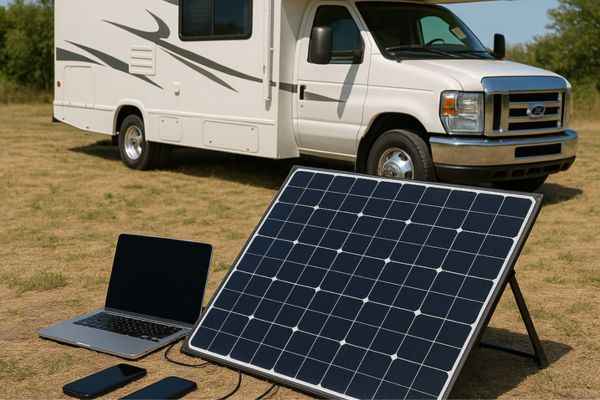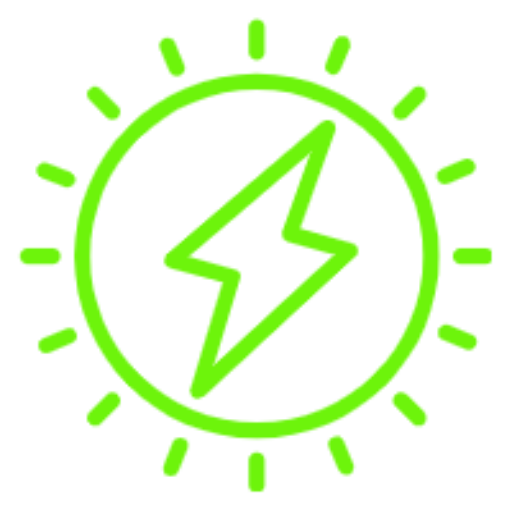Disclaimer: This post contains affiliate links. If you buy through these links, we may earn a commission. As an Amazon Associate, I earn from qualifying purchases.
How many solar panels do I need for my RV? This is one of the most common questions RV owners ask when switching to solar power. Solar energy is a clean, quiet, and cost-effective way to stay powered on the road.
Many RVers are making the switch to avoid noisy generators and save money on campground hookups. Solar gives you the freedom to camp off-grid with confidence.
In this guide, you’ll learn how much solar power you need for your RV, what size panels to choose, and how to size your RV solar system step by step.
How Much Solar Power Do I Need for My RV?
How many solar panels do I need for my RV? First, you need to know how much power you use every day — and it’s probably more than you think. Here’s what a typical RV setup looks like over 24 hours:
- 12V fridge: ~700Wh
- LED lights (4–5 hrs): ~100Wh
- Phone & laptop charging: ~200Wh
- Ceiling fan or vent fan: ~150Wh
- Water heater or coffee maker (short use): ~300Wh
- TV or music system: ~200Wh
In total, that’s around 1,500 to 2,000Wh, or 1.5 to 2 kWh per day. If you work remotely, run a Starlink, or use heavier appliances, your daily usage might go up to 3 kWh or more.
Once you know your daily needs, it’s easier to size your system. To skip the complicated math, you can always start with one of the best RV solar panel kits built for these exact needs.

How to Size a Solar System for an RV (Step-by-Step)
Sizing your RV solar system doesn’t have to be a headache. Once you understand your energy needs, everything else falls into place. Here’s how to do it — step by step:
#Step 1: Calculate your daily energy use
Calculate your daily energy use in watt-hours (Wh) or kilowatt-hours (kWh). Use our earlier example or add up the wattage of your devices and how long you use them.
Step 2: Add a Buffer for Real-World Conditions
Solar isn’t always 100% reliable — cloudy days, shade, and winter sun can reduce output. That’s why it’s smart to add a 20–30% buffer to your total energy needs.
For example, if your estimated usage is 1,340Wh/day, you should plan for around 1,600–1,750Wh/day to stay powered comfortably.
#Step 3: Calculate the Solar Wattage You Need
Now divide your daily watt-hour needs (including the buffer) by the average peak sun hours you get per day. In most parts of the U.S., you can expect 4 to 6 hours of good solar generation.
Example:
1,750Wh ÷ 5 sun hours = 350W of solar panels minimum.
This means you’ll need at least 350W of solar panel capacity — or more if you plan to stay off-grid longer or want faster charging.
#Step 4: Choose the Right Type of Solar Panel
So, you’d need at least 350 watts of solar panel capacity. But here’s what that really looks like in panel choices:
- One 400W panel might technically cover your needs, but it leaves little room for cloudy days or extra use.
- Two 200W panels offer a more balanced setup and flexibility in layout.
- Three 150W panels (totaling 450W) give you buffer and are easier to arrange if space is limited.
- Four 100W panels (totaling 400W) are a common budget setup, especially for small-to-medium RVs.
If you want faster battery charging or plan to run more appliances (like a CPAP, electric cooktop, or TV), consider adding an extra panel or two. This not only builds in reliability but also keeps your batteries topped up even during partial sun.
💡 Tip: Many RVers go with 400W to 600W total capacity for comfortable off-grid living. Want a quick start without overthinking the math? Look into the best RV solar panel kits — they’re bundled for common RV energy needs and come ready to install.
🧮 Want to skip the math? Try our free RV Solar Calculator to find out exactly how many panels you need.
Sample RV Setups: How Many Solar Panels Do I Need for My RV?
Still wondering how many solar panels do I need for my RV? Let’s break it down with real-world examples. Whether you’re a weekend camper or a full-time road warrior, here’s what typical RV setups look like:
🌄Weekend Camper (Low Power Needs)
Daily usage: ~1 kWh (1,000 watt-hours)
This setup usually powers LED lights, a small fan, phone/laptop charging, and occasional use of a fridge.
Recommended solar: 200–300W
This could mean:
- One 200W rigid panel
- Two 100W panels
- Or one of the best 200W RV solar panels for a compact, efficient option
This is perfect if you mostly camp in sunny weather and have limited energy needs.
💻 Remote Worker or Full-Time RVer
Daily usage: 2–3 kWh
You might be running a laptop, fridge, fan, router, lights, and charging devices daily—plus occasional use of a coffee maker or TV.
Recommended solar: 400–600W
Ideal setup:
- Two or three 200W panels
- Combine multiple best portable solar panels for flexible placement when parked
- Or go for the best RV solar panel kits that include panels, charge controller, wiring, and mounts
This range suits digital nomads who want energy reliability for work and leisure.
🧳 Off-Grid Traveler (Heavy Power Use)
Daily usage: 3–4.5 kWh
Think induction cooktops, larger refrigerators, entertainment systems, CPAP machines, and long-term boondocking.
Recommended solar: 600–800W (or more)
What works best:
- Four 200W portable panels or two 400W portable panels
- A mix of rigid and best flexible solar panels to maximize limited roof space
- May require tilt mounts for better sun exposure (see how to mount panel on RV)
At this level, solar becomes your primary power source. You’ll also want a strong battery bank and possibly a backup generator.
Factors That Affect Your RV Solar Setup
Every RVer’s needs are different — and so is their solar setup. Here are the key things that influence how much solar power you’ll need (and what kind of panels will work best):
☀️ Sunlight Availability
Where you camp matters a lot. Boondocking in the sunny Southwest? You might get 6+ peak sun hours a day. But in cloudy areas like the Pacific Northwest, that number could drop to 3–4. Fewer sun hours mean you’ll need more panel capacity to generate the same power.
🚐 Roof Space
Limited roof space can be a real challenge, especially on smaller RVs or camper vans. That’s where best flexible solar panels come in handy — they’re lightweight, bendable, and ideal for curved or tight roof areas where rigid panels won’t fit.
🔋 Battery Capacity
Solar panels don’t power your devices directly — they charge your batteries. So if your battery bank is too small, you’ll run out of power no matter how many panels you have. Make sure your battery setup can store enough energy for your daily needs, with some buffer for cloudy days.
🟦 Panel Type
Choosing the right type of solar panel affects both performance and convenience. Rigid panels are durable and efficient, perfect for fixed installations. But if you prefer flexibility (literally), best portable solar panels let you park in the shade and still charge in the sun. Some RVers even mix both types for the best of both worlds.
Best Solar Panels for RVs in 2025
1. HQST 100 Watt 12V Monocrystalline Solar Panel
The HQST 100 Watt 12V Monocrystalline Solar Panel offers high efficiency, making it ideal for off-grid applications like RVs, boats, and caravans. It comes with solar connectors for easy installation and reliable battery charging.
2. BALDR 200W Monocrystalline Solar Panels
The BALDR 200W Monocrystalline Portable Folding Solar Charger is perfect for camping and off-grid living, offering high efficiency and portability. This solar panel kit is compatible with solar generators and portable power stations for reliable power on the go.
3. BLUETTI 350W Solar Panel
The BLUETTI 350W Solar Panel is a high-efficiency, foldable solar charger designed for solar generators like the AC70, AC180, and AC200L. Ideal for RVs, camping, and power outages, it provides reliable off-grid power with its compact, portable design.
4. MHPOWOS 400W Portable Solar Panel
The 400W Portable Solar Panel is a lightweight, foldable solar charger designed for outdoor adventures. Featuring an adjustable kickstand and IP67 waterproof rating, it’s perfect for camping, RVs, and powering portable stations in all weather conditions.
5. ZOUPW N-Type 16BB 450W Portable Solar Panel
The N-Type 16BB 450W Portable Solar Panel offers 25% high efficiency and a 38V output, making it ideal for power stations during power outages. With IP68 waterproofing and reinforced kickstands, it’s perfect for camping, RVs, and hurricane preparedness.
Conclusions!
In conclusion, determining how many solar panels do you need for your RV depends on your energy usage, travel style, and available roof space. By calculating your daily power needs and considering factors like sunlight hours and panel types, you can make an informed decision.
Whether you’re a weekend camper or a full-time RVer, understanding your energy requirements is key to setting up an efficient solar system. With the right panels, like the best RV solar panel kits, you’ll enjoy reliable off-grid power wherever your adventures take you.
FAQs: how many solar panels do I need for my RV
How do I calculate how many solar panels I need for my RV?
To calculate how many solar panels you need, determine your daily energy consumption in watt-hours (Wh), add a 20-30% buffer for cloudy days, and divide by the number of sun hours you typically get. This will give you the total wattage needed for your RV solar system.
What size solar panels are best for an RV?
The best size depends on your energy needs. For small setups, 100W to 200W panels are usually sufficient, while larger setups may require 300W to 600W panels or more, especially for full-time RV living or off-grid camping.
Can I use flexible solar panels on my RV?
Yes! Flexible solar panels are a great option for RVs with limited roof space or curved surfaces. They’re lightweight, durable, and easy to mount on unconventional surfaces, making them ideal for compact RV setups.
How much solar power do I need for my RV?
The amount of solar power you need depends on your daily energy consumption. A typical RV setup might need anywhere from 200W to 800W of solar panels, depending on your appliances, travel habits, and how much off-grid time you plan to spend.
What is the best solar panel kit for an RV?
The best RV solar panel kit depends on your power requirements and space. Some popular options include kits with 200W to 400W panels, charge controllers, and mounting hardware, like the best RV solar panel kits that come complete for easy installation and efficiency.

